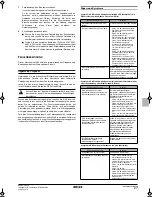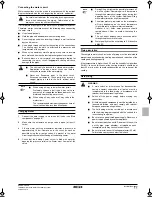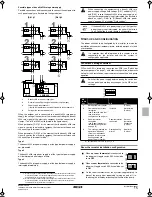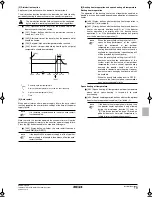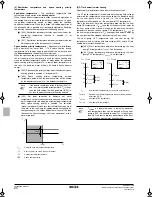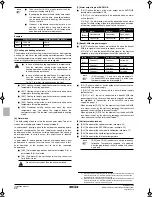
RKHBH/X016AB
Indoor unit for air to water heat pump system
4PW50205-1A
Installation manual
11
Connecting the water circuit
Water connections must be made in accordance with the outlook
diagram delivered with the unit, respecting the water in- and outlet.
If air, moisture or dust gets in the water circuit, problems may occur.
Therefore, always take into account the following when connecting
the water circuit:
■
Use clean pipes only.
■
Hold the pipe end downwards when removing burrs.
■
Cover the pipe end when inserting it through a wall so that no
dust and dirt enter.
■
Use a good thread sealant for the sealing of the connections.
The sealing must be able to withstand the pressures and
temperatures of the system.
■
When using non-brass metallic piping, make sure to insulate
both materials from each other to prevent galvanic corrosion.
■
Because brass is a soft material, use appropriate tooling for
connecting the water circuit. Inappropriate tooling will cause
damage to the pipes.
Charging water
1
Connect the water supply to a drain and fill valve (see "Main
components" on page 6).
2
Make sure the automatic air purge valve is open (at least 2
turns).
3
Fill with water until the manometer indicates a pressure of
approximately 2.0 bar. Remove air in the circuit as much as
possible using the air purge valves. Air present in the water
circuit might cause malfunctioning of the backup heater.
4
Check that the backup heater vessel is filled with water by
opening the pressure relief valve. Water must flow out of the
valve.
Piping insulation
The complete water circuit, inclusive all piping, must be insulated to
prevent condensation during cooling operation and reduction of the
cooling and heating capacity.
If the temperature is higher than 30°C and the humidity is higher than
RH 80%, then the thickness of the sealing materials should be at
least 20 mm in order to avoid condensation on the surface of the
sealing.
Field wiring
Be careful not to deform the unit piping by using excessive
force when connecting the piping. Deformation of the
piping can cause the unit to malfunction.
■
The unit is only to be used in a closed water system.
Application in an open water circuit can lead to
excessive corrosion of the water piping.
■
Never use Zn-coated parts in the water circuit.
Excessive corrosion of these parts may occur as
copper piping is used in the unit's internal water
circuit.
NOTE
■
When using a 3-way valve in the water circuit.
Preferably choose a ball type 3-way valve to
guarantee full separation between domestic hot
water and floor heating water circuit.
■
When using a 3-way valve or a 2-way valve in the
water circuit.
The recommended maximum changeover time of
the valve should be less than 60 seconds.
NOTE
■
During filling, it might not be possible to remove all
air in the system. Remaining air will be removed
through the automatic air purge valves during first
operating hours of the system. Additional filling
with water afterwards might be required.
■
The water pressure indicated on the manometer
will vary depending on the water temperature
(higher pressure at higher water temperature).
However, at all times water pressure should
remain above 0.3 bar to avoid air entering the
circuit.
■
The unit might dispose some excessive water
through the pressure relief valve.
■
Water quality must be according to EN directive
98/83 EC.
WARNING
■
A main switch or other means for disconnection,
having a contact separation in all poles, must be
incorporated in the fixed wiring in accordance with
relevant local and national legislation.
■
Switch off the power supply before making any
connections.
■
All field wiring and components must be installed by a
licensed electrician and must comply with relevant
European and national regulations.
■
The field wiring must be carried out in accordance
with the wiring diagram supplied with the unit and the
instructions given below.
■
Be sure to use a dedicated power supply. Never use a
power supply shared by another appliance.
■
Be sure to establish an earth. Do not earth the unit to
a utility pipe, surge absorber, or telephone earth.
Incomplete earth may cause electrical shock.
■
Be sure to install an earth leakage protector (30 mA).
Failure to do so may cause electrical shock.
1D_IM_4PW50205-1A.book Page 11 Thursday, January 29, 2009 12:00 PM

